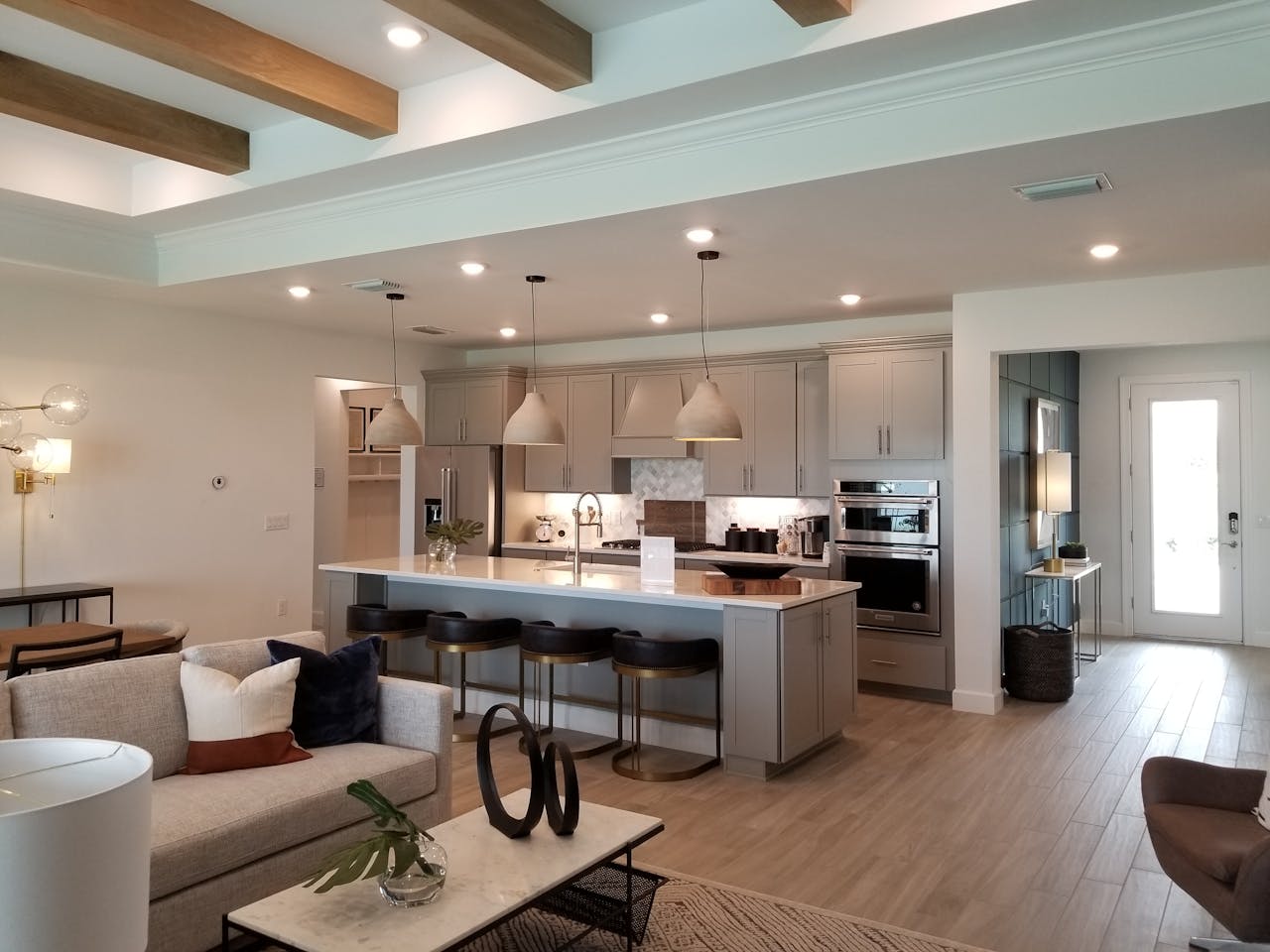Understanding the latest kitchen lighting trends can help you create a space that is both functional and stylish. Whether you’re a homeowner looking to update your space, or an interior designer in need of fresh inspiration, we’ve compiled the most popular trends lighting up kitchens across the UK. From the sleek and modern to the warm and traditional, these ideas will illuminate your design process in ways you may never have thought possible.
The Rise of LED Lights
LED lights are becoming increasingly popular in kitchen design. They offer a wide range of advantages, including energy efficiency, long lifespan, and versatility in colour and brightness. LED lights also emit less heat than other types of bulbs, making them a safe choice for kitchen use.
In parallel : How do you choose the right kitchen countertop material for durability and aesthetics?
In recent years, the trend for LED lighting in kitchens has leaned toward the creative and visually striking. Designers are utilising LEDs to highlight specific areas, such as under cabinets or above islands, to create a layered lighting design. LED strip lights are a particularly popular choice due to their flexibility and ease of installation.
The trend also extends to fixtures and accessories. LED pendant lights, for instance, are becoming a popular way to add a modern touch to kitchen spaces. Available in a variety of shapes, sizes, and designs, these pendants can serve both as task lighting and design features in a kitchen.
Also to discover : Is it worth investing in a boiling water tap for your UK kitchen?
Statement Pendant Lights Over Kitchen Islands
A lighting trend that has been steadily gaining momentum in the UK is the use of statement pendant lights over kitchen islands. These lights serve a dual purpose: they provide focused task lighting for cooking or meal prep, and also serve as an eye-catching design element in the kitchen.
Pendant lights can be customised to suit any kitchen design. For modern kitchens, sleek and minimalist pendant lights in metals like chrome or brushed nickel are popular. For more traditional or rustic kitchens, pendant lights in materials like wrought iron or distressed wood can add a warm and inviting touch.
When choosing pendant lights for your kitchen island, consider the size and style of your island, as well as the overall design of your kitchen. The key is to balance function with aesthetic appeal to create a lighting design that is both practical and pleasing to the eye.
Playing with Wall Lights
Wall lights are a fun and functional way to add character to your kitchen. They offer a lot of flexibility in terms of where and how you can use them, making them a versatile choice for any kitchen design. From modern sconces to traditional lantern-style fixtures, wall lights can add an interesting visual element to your kitchen while also providing essential task lighting.
One of the current trends in kitchen wall lighting is the use of swing arm lights. These fixtures allow you to adjust the direction and focus of the light, which is particularly useful for tasks like cooking or dishwashing. Swing arm lights also add a unique design element to your kitchen, with their vintage-inspired design and industrial chic appeal.
Another trend is the use of wall lights to highlight architectural features or artwork in the kitchen. This is a great way to add some personality to your space and create a focal point in your kitchen design.
Adding Colour with Lighting
One of the more exciting kitchen lighting trends in the UK is the use of colour. More designers and homeowners are turning to colourful light fixtures as a way to add a pop of personality to their kitchens. Whether it’s a brightly coloured pendant light over the kitchen island or a set of pastel wall lights, adding colour with your lighting is a great way to liven up your kitchen.
LED lights are particularly suited to this trend, as they are available in a wide range of colours. You can even find LED lights that can be programmed to change colours, allowing you to alter the mood of your kitchen at the push of a button.
Remember that balance is key when adding colour with lighting. You want to create a vibrant and energizing space, but you don’t want to overwhelm the room with too many competing colours. Stick to a cohesive colour scheme, and consider the other colours in your kitchen design.
Emphasizing Natural Light
Our final trend takes us away from artificial lights and toward the organic: the emphasis on natural light. The design of modern kitchens is increasingly focused on maximizing natural light. This not only helps to create a brighter and more welcoming space, but also has the added benefit of being more energy-efficient.
One of the ways this trend is being implemented is through the use of large windows or skylights in the kitchen. These allow ample sunlight to flood the room, reducing the need for artificial lighting during the day.
Another method is the use of light, reflective surfaces in the kitchen. These can help to bounce light around the room, further enhancing the natural light. Light-coloured or glossy cabinets, shiny metal appliances, and reflective backsplashes are all effective ways to increase the amount of natural light in your kitchen.
In conclusion, lighting is a key element in kitchen design. It not only serves a functional purpose but also plays a significant role in setting the mood and style of the space. Whether you opt for LED lights, colourful fixtures, or an emphasis on natural light, remember to consider both the practical and aesthetic aspects of your kitchen lighting design.
The Popularity of Under-Cabinet Lighting
Under-cabinet lighting is a trend that is seeing a surge in popularity in UK kitchens. This type of lighting provides illumination for kitchen tasks such as food preparation and cooking, while also highlighting the beauty of the countertop and backsplash. Under-cabinet lighting is a practical yet stylish addition to any kitchen design.
LEDs are often the preferred choice for under-cabinet lighting due to their energy efficiency, long lifespan, and versatility. They can be fitted to provide a continuous strip of light or installed as individual pendants, each casting a pool of light onto the work surface below. The LED colour can be warm or cool, depending on the desired ambience and the overall colour scheme of the kitchen.
One of the benefits of under-cabinet lighting is that it does not create shadows, as can happen with ceiling lights. This makes it an excellent option for task lighting. Additionally, with the use of dimmer switches, the brightness of under-cabinet lights can be adjusted to suit different times of the day and various activities.
Under-cabinet lights can also be used to showcase the special features of a kitchen. For example, they can be used to highlight a unique backsplash, a luxurious marble countertop or a beautiful collection of crockery.
Lighting as Part of Open Plan Living
The trend of open-plan living has been steadily rising in the UK, and as a result, kitchen lighting has evolved to accommodate this trend. Instead of being a separate space, the kitchen is now an integral part of the living area. Therefore, lighting needs to be considered not just in the context of the kitchen, but in relation to the entire living space.
In open-plan designs, lighting can be used to delineate distinct areas without the need for walls. For instance, a set of pendant lights over the kitchen island could signal the boundary of the kitchen space within the larger living area. Likewise, strategic use of wall lights can create a sense of separation between the cooking and dining areas.
Recessed lighting can also be a great option for open-plan kitchens. These lights are embedded into the ceiling, providing illumination without visually intruding on the space. This gives the kitchen a clean, minimal look, which is often desired in open-plan designs.
To create a cohesive look in an open-plan kitchen, it is advisable to harmonise the lighting style with the rest of the living area. This doesn’t necessarily mean that all fixtures have to be identical, but they should share a similar design aesthetic.
Conclusion
To conclude, the current trends in UK kitchen lighting are varied and exciting, providing ample opportunity for homeowners and designers to get creative. Whether it’s the rise of LED lights, the popularity of statement pendant lights over kitchen islands, the playful use of wall lights, the addition of colour with lighting, the emphasis on natural light, the implementation of under-cabinet lighting, or the consideration of lighting in open-plan living, there is a wealth of lighting ideas to suit every taste and need. The key to successful kitchen lighting design lies in balancing functionality with aesthetics, and in considering the kitchen lighting in relation to the overall design of the home. So, when planning your kitchen lighting, remember to consider both practicality and aesthetics, and most importantly, let your choices reflect your individual style and the ambience you wish to create in your kitchen space.






